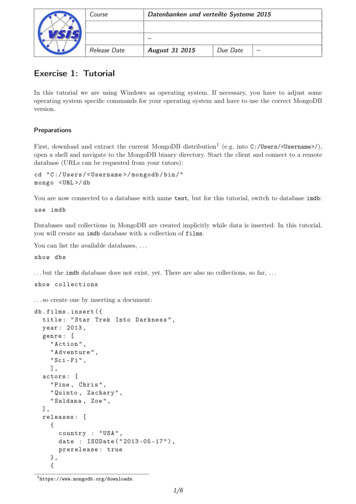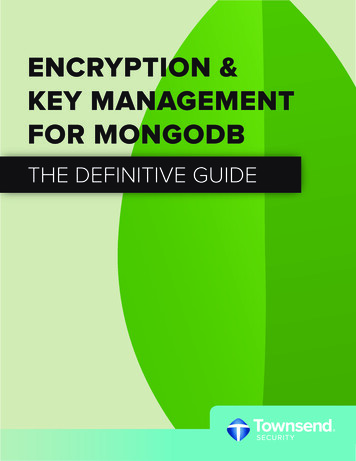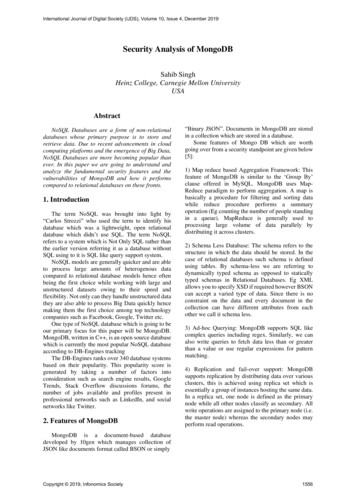
Transcription
MongoDB#mongodbwww.dbooks.org
Table of ContentsAbout1Chapter 1: Getting started with lo World6Complementary Terms6Execution of a JavaScript file in MongoDB7Making the output of find readable in shell7Basic commands on mongo shell8Chapter 2: 2dsphere IndexExamplesCreate a 2dsphere IndexChapter 3: Remarks10Examples10Count10Sum11Average12Operations with arrays.13Match13Remove docs that have a duplicate field in a collection (dedupe)14Chapter 4: Authentication Mechanisms in MongoDB15Introduction15Examples15Authentication Mechanisms15
Chapter 5: Backing up and Restoring DataExamples1616mongoimport with JSON16mongoimport with CSV16Chapter 6: Backing up and Restoring DataExamples1818Basic mongodump of local default mongod instance18Basic mongorestore of local default mongod dump18Chapter 7: Bulk Operations19Remarks19Examples19Converting a field to another type and updating the entire collection in BulkChapter 8: Collections1922Remarks22Examples22Create a Collection22Drop Collection23Chapter 9: Configuration24Parameters24Examples26Starting mongo with a specific config fileChapter 10: CRUD date28Delete28Read29More update operators30"multi" Parameter while updating multiple documents30Update of embedded documents.31www.dbooks.org
Chapter 11: Getting database informationExamples3232List all databases32List all collections in database32Chapter 12: Indexes33Syntax33Remarks33Examples33Single field33Compound33Delete33List34Index Creation Basics34Hashed indexes36Dropping/Deleting an Index36Get Indices of a Collection37Unique Index37Sparse indexes and Partial indexes37Chapter 13: Java DriverExamples3939Create a tailable cursor39Create a database user39Fetch Collection data with condition39Chapter 14: Managing MongoDB41ExamplesListing currently running queriesChapter 15: Mongo as a Replica SetExamplesMongodb as a Replica SetChapter 16: Mongo as a Replica SetExamplesCheck MongoDB Replica Set states4141424242444444
Chapter 17: Mongo as ShardsExamplesSharding Environment SetupChapter 18: MongoDB - Configure a ReplicaSet to support TLS/SSL46464648Introduction48Examples48How to configure a ReplicaSet to support TLS/SSL?48Create the Root Certificate48Generate the Certificate Requests and the Private Keys48Sign your Certificate Requests49Concat each Node Certificate with its key49Deploy your ReplicaSet50Deploy your ReplicaSet for Mutual SSL / Mutual Trust50How to connect your Client (Mongo Shell) to a ReplicaSet?50No Mutual SSL50With Mutual SSL51Chapter 19: MongoDB AggregationExamples5353Aggregate query examples useful for work and learning53Java and Spring example57Get sample data58Left Outer Join with aggregation ( Lookup)58Chapter 20: MongoDB Authorization Model60Introduction60Examples60Build-in RolesChapter 21: Pluggable Storage w.dbooks.org
How to use WiredTiger 2Chapter 22: Python Driver63Syntax63Parameters63Examples63Connect to MongoDB using pymongo63PyMongo queries63Update all documents in a collection using PyMongo64Chapter 23: Querying for Data ( Getting Started y Document - Using AND, OR and IN Conditions66find() method with Projection68Find() method with Projection68limit, skip, sort and count the results of the find() method69Chapter 24: ReplicationExamplesBasic configuration with three nodesChapter 25: Update ples73 set operator to update specified field(s) in document(s)73I.Overview73II.What happen if we don't use update operators?73
III. set operator74Chapter 26: Upgrading MongoDB g to 3.4 on Ubuntu 16.04 using aptChapter 27: Upserts and InsertsExamplesInsert a documentCredits7677777778www.dbooks.org
AboutYou can share this PDF with anyone you feel could benefit from it, downloaded the latest versionfrom: mongodbIt is an unofficial and free MongoDB ebook created for educational purposes. All the content isextracted from Stack Overflow Documentation, which is written by many hardworking individuals atStack Overflow. It is neither affiliated with Stack Overflow nor official MongoDB.The content is released under Creative Commons BY-SA, and the list of contributors to eachchapter are provided in the credits section at the end of this book. Images may be copyright oftheir respective owners unless otherwise specified. All trademarks and registered trademarks arethe property of their respective company owners.Use the content presented in this book at your own risk; it is not guaranteed to be correct noraccurate, please send your feedback and corrections to info@zzzprojects.comhttps://riptutorial.com/1
Chapter 1: Getting started with MongoDBRemarks Data in the world started to grow tremendously after mobile application came in the market.This huge amount of data became almost impossible to handle with traditional relationaldatabase - SQL. NoSQL databases are introduced to handle those data where much moreflexibility came like variable number of columns for each data. MongoDB is one of the leading NoSQL databases. Each collection contains a number ofJSON documents. Any data model that can be expressed in a JSON document can be easilystored in MongoDB. MongoDB is a server-client database. Server usually runs with the binary file mongod andclient runs with mongo. There is no join operation in MongoDB prior to v.3.2, for various philosophical and pragmaticreasons. But Mongo shell supports javascript, so if lookup is not available, one can simulatejoin operations on documents in javascript before inserting. To run an instance in production environment, it's strongly advised to follow the OperationsChecklist.VersionsVersionRelease ps://riptutorial.com/2www.dbooks.org
ExamplesInstallationTo install MongoDB, follow the steps below: For Mac OS: There are two options for Mac OS: manual install or homebrew.Installing with homebrew:Type the following command into the terminal: brew install mongodb Installing manually: Download the latest release here. Make sure that you are downloading theappropriate file, specially check whether your operating system type is 32-bit or64-bit. The downloaded file is in format tgz.Go to the directory where this file is downloaded. Then type the followingcommand: tar xvf mongodb-osx-xyz.tgzInstead of xyz, there would be some version and system type information. Theextracted folder would be same name as the tgz file. Inside the folder, their wouldbe a subfolder named bin which would contain several binary file along withmongod and mongo. By default server keeps data in folder /data/db. So, we have to create thatdirectory and then run the server having the following commands: #### sudo bashmkdir -p /data/dbchmod 777 /datachmod 777 /data/dbexitTo start the server, the following command should be given from the currentlocation: ./mongodIt would start the server on port 27017 by default. To start the client, a new terminal should be opened having the same directory asbefore. Then the following command would start the client and connect to thehttps://riptutorial.com/3
server. ./mongoBy default it connects to the test database. If you see the line like connecting to:test. Then you have successfully installed MongoDB. Congrats! Now, you cantest Hello World to be more confident. For Windows: Download the latest release here. Make sure that you are downloading the appropriatefile, specially check whether your operating system type is 32-bit or 64-bit.The downloaded binary file has extension exe. Run it. It will prompt an installationwizard. Click Next. Accept the licence agreement and click Next. Select Complete Installation. Click on Install. It might prompt a window for asking administrator's permission. ClickYes.After installation click on Finish.Now, the mongodb is installed on the path C:/Program Files/MongoDB/Server/3.2/bin.Instead of version 3.2, there could be some other version for your case. The path namewould be changed accordingly.directory contain several binary file along with mongod and mongo. To run it from otherfolder, you could add the path in system path. To do it:bin Right click on My Computer and select Properties.Click on Advanced system setting on the left pane.Click on Environment Variables. under the Advanced tab.Select Path from System variables section and click on Edit.Before Windows 10, append a semi-colon and paste the path given above. FromWindows 10, there is a New button to add new path.Click OKs to save changes.Now, create a folder named data having a sub-folder named db where you want to runthe server.Start command prompt from their. Either changing the path in cmd or clicking on Opencommand window here which would be visible after right clicking on the empty spaceof the folder GUI pressing the Shift and Ctrl key together.Write the command to start the server:https://riptutorial.com/4www.dbooks.org
mongodIt would start the server on port 27017 by default. Open another command prompt and type the following to start client: mongo By default it connects to the test database. If you see the line like connecting to: test.Then you have successfully installed MongoDB. Congrats! Now, you can test HelloWorld to be more confident. For Linux: Almost same as Mac OS except some equivalent command is needed. For Debian-based distros (using apt-get): Import MongoDB Repository key. sudo apt-key adv --keyserver hkp://keyserver.ubuntu.com:80 --recv EA312927gpg: Total number processed: 1\gpg:imported: 1 (RSA: 1) Add repository to package list on Ubuntu 16.04. echo "deb http://repo.mongodb.org/apt/ubuntu xenial/mongodb-org/3.2multiverse" sudo tee /etc/apt/sources.list.d/mongodb-org-3.2.list on Ubuntu 14.04. echo "deb http://repo.mongodb.org/apt/ubuntu trusty/mongodb-org/3.2multiverse" sudo tee /etc/apt/sources.list.d/mongodb-org-3.2.list Update package list. sudo apt-get update Install MongoDB. sudo apt-get install mongodb-org For Red Hat based distros (using yum): use a text editor which you prefer. vi /etc/yum.repos.d/mongodb-org-3.4.repo Paste following text.[mongodb-org-3.4]https://riptutorial.com/5
name MongoDB Repositorybaseurl https://repo.mongodb.org/yum/redhat/ releasever/mongodborg/3.4/x86 64/gpgcheck 1enabled 1gpgkey https://www.mongodb.org/static/pgp/server-3.4.asc Update package list. sudo yum update Install MongoDB sudo yum install mongodb-orgHello WorldAfter installation process, the following lines should be entered in mongo shell (client terminal). db.world.insert({ "speech" : "Hello World!" }); cur db.world.find();x cur.next();print(x["speech"]);Hello World!Explanation: In the first line, we have inserted a { key : value } paired document in the default databasetest and in the collection named world. In the second line we retrieve the data we have just inserted. The retrieved data is kept in ajavascript variable named cur. Then by the next() function, we retrieved the first and onlydocument and kept it in another js variable named x. Then printed the value of the documentproviding the key.Complementary TermsSQL TermsMongoDB TermsDatabaseDatabaseTableCollectionEntity / RowDocumentColumnKey / FieldTable JoinEmbedded DocumentsPrimary KeyPrimary Key (Default key id provided by mongodb itself)https://riptutorial.com/6www.dbooks.org
Execution of a JavaScript file in MongoDB./mongo localhost:27017/mydb myjsfile.jsExplanation: This operation executes the myjsfile.js script in a mongo shell that connects to themydb database on the mongod instance accessible via the localhost interface on port 27017.localhost:27017 is not mandatory as this is the default port mongodb uses.Also, you can run a .js file from within mongo console. load("myjsfile.js")Making the output of find readable in shellWe add three records to our collection test as: ":"val3"})WriteResult({ "nInserted" : 1 }) 3":"val31"})WriteResult({ "nInserted" : 1 }) 3":"val33"})WriteResult({ "nInserted" : 1 })If we see them via find, they will look very ugly. db.test.find(){ " id" : ObjectId("5790c5cecae25b3d38c3c7ae"), "key" : "value1", "key2" : "Val2", "key3" : "val3" }{ " id" : ObjectId("5790c5d9cae25b3d38c3c7af"), "key" : "value2", "key2" : "Val21", "key3" : "val31" }{ " id" : ObjectId("5790c5e9cae25b3d38c3c7b0"), "key" : "value3", "key2" : "Val22", "key3" : "val33" }To work around this and make them readable, use the pretty() function. db.test.find().pretty(){" id" : ObjectId("5790c5cecae25b3d38c3c7ae"),"key" : "value1","key2" : "Val2","key3" : "val3"}{" id" : ObjectId("5790c5d9cae25b3d38c3c7af"),"key" : "value2","key2" : "Val21","key3" : "val31"}{" id" : ObjectId("5790c5e9cae25b3d38c3c7b0"),"key" : "value3","key2" : "Val22","key3" : "val33"https://riptutorial.com/7
} Basic commands on mongo shellShow all available databases:show dbs;Select a particular database to access, e.g. mydb. This will create mydb if it does not already exist:use mydb;Show all collections in the database (be sure to select one first, see above):show collections;Show all functions that can be used with the database:db.mydb.help();To check your currently selected database, use the command db dbmydbdb.dropDatabase()command is used to drop a existing database.db.dropDatabase()Read Getting started with MongoDB online: ooks.org
Chapter 2: 2dsphere IndexExamplesCreate a 2dsphere Indexdb.collection.createIndex()method is used to create a 2dsphere index. The blueprint of a 2dsphereindex :db.collection.createIndex( { location field : "2dsphere" } )Here, the location field is the key and 2dsphere is the type of the index. In the following examplewe are going to create a 2dsphre index in the places collection.db.places.insert({loc : { type: "Point", coordinates: [ -73.97, 40.77 ] },name: "Central Park",category : "Parks"})The following operation will create 2dsphere index on the loc field of places collection.db.places.createIndex( { loc : "2dsphere" } )Read 2dsphere Index online: e-indexhttps://riptutorial.com/9
Chapter 3: AggregationIntroductionoperations process data records and return computed results. Aggregationoperations group values from multiple documents together, and can perform a variety ofoperations on the grouped data to return a single result. MongoDB provides three ways to performaggregation: the aggregation pipeline, the map-reduce function, and single purpose aggregationmethods.AggregationsFrom Mongo manual https://docs.mongodb.com/manual/aggregation/Syntax db.collection.aggregate(pipeline, options)ParametersParameterDetailspipelinearray(A sequence of data aggregation operations or stages)optionsdocument(optional, available only if pipeline present as an array)RemarksAggregation framework in MongoDB is used to achieve common GROUPBYfunctionality of SQL.Consider the following insertions in collection named transactions for every example. nsactions.insert({cr drcr drcr drcr drcr drcr drcr ;4});2});4});2});ExamplesCountHow do you get the number of Debit and Credit transactions? One way to do it is by using count()function as below.https://riptutorial.com/10www.dbooks.org
db.transactions.count({cr dr : "D"});or db.transactions.find({cr dr : "D"}).length();But what if you do not know the possible values of cr dr upfront. Here Aggregation frameworkcomes to play. See the below Aggregate query. db.transactions.aggregate([{ group : {id : ' cr dr', // group by type of transaction// Add 1 for each document to the count for this type of transactioncount : { sum : 1}}}]);And the result is{" id" : "C","count" : 3}{" id" : "D","count" : 5}SumHow to get the summation of amount? See the below aggregate query. db.transactions.aggregate([{ group : {id : ' cr dr',count : { sum : 1},//counts the numbertotalAmount : { sum : ' amount'}//sums the amount}}]);And the result is{" id" : "C","count" : 3.0,https://riptutorial.com/11
"totalAmount" : 120.0}{" id" : "D","count" : 5.0,"totalAmount" : 410.0}Another version that sums amount and fee. db.transactions.aggregate([{ group : {id : ' cr dr',count : { sum : 1},totalAmount : { sum : { sum : [' amount', ' fee']}}}}]);And the result is{" id" : "C","count" : 3.0,"totalAmount" : 128.0}{" id" : "D","count" : 5.0,"totalAmount" : 422.0}AverageHow to get the average amount of debit and credit transactions? db.transactions.aggregate([{ group : {id : ' cr dr', // group by type of transaction (debit or credit)count : { sum : 1},// number of transaction for each typetotalAmount : { sum : { sum : [' amount', ' fee']}},// sumaverageAmount : { avg : { sum : [' amount', ' fee']}}// average}}])The result is{https://riptutorial.com/12www.dbooks.org
" id" : "C", // Amounts for credit transactions"count" : 3.0,"totalAmount" : 128.0,"averageAmount" : 40.0}{" id" : "D", // Amounts for debit transactions"count" : 5.0,"totalAmount" : 422.0,"averageAmount" : 82.0}Operations with arrays.When you want to work with the data entries in arrays you first need to unwind the array. Theunwind operation creates a document for each entry in the array. When you have lot's ofdocuments with large arrays you will see an explosion in number of documents.{ " id" : 1, "item" : "myItem1", sizes: [ "S", "M", "L"] }{ " id" : 2, "item" : "myItem2", sizes: [ "XS", "M", "XL"] }db.inventory.aggregate( [ { unwind : " sizes" }] )An important notice is that when a document doesn't contain the array it will be lost. From mongo3.2 and up there are is an unwind option "preserveNullAndEmptyArrays" added. This optionmakes sure the document is preserved when the array is missing.{ " id" : 1, "item" : "myItem1", sizes: [ "S", "M", "L"] }{ " id" : 2, "item" : "myItem2", sizes: [ "XS", "M", "XL"] }{ " id" : 3, "item" : "myItem3" }db.inventory.aggregate( [ { unwind : { path: " sizes", includeArrayIndex: "arrayIndex" } }] )MatchHow to write a query to get all departments where average age of employees making less than or 70000 is greather than or equal to 35?In order to that we need to write a query to match employees that have a salary that is less than orequal to 70000. Then add the aggregate stage to group the employees by the department. Thenadd an accumulator with a field named e.g. average age to find the average age per departmentusing the avg accumulator and below the existing match and group aggregates add another match aggregate so that we're only retrieving results with an average age that is greather thanor equal to 35.db.employees.aggregate([{" match": {"salary": {" lte": 70000}}},{" group": {" id": " dept","average age": {" avg": " age"}}},{" match": {"average age": {" gte": 35}}}https://riptutorial.com/13
])The result is:{" id": "IT","average age": 31}{" id": "Customer Service","average age": 34.5}{" id": "Finance","average age": 32.5}Remove docs that have a duplicate field in a collection (dedupe)Note that the allowDiskUse: true option is optional but will help mitigate out of memory issues asthis aggregation can be a memory intensive operation if your collection size is large - so irecommend to always use it.var duplicates [];db.transactions.aggregate([{ group: {id: { cr dr: " cr dr"},dups: { " addToSet": " id" },count: { " sum": 1 }}},{ match: {count: { " gt": 1 }}}],allowDiskUse: true}).result.forEach(function(doc) {doc.dups.shift();doc.dups.forEach( function(dupId){duplicates.push(dupId);})})// printjson(duplicates);// Remove all duplicates in one godb.transactions.remove({ id:{ in:duplicates}})Read Aggregation online: tionhttps://riptutorial.com/14www.dbooks.org
Chapter 4: Authentication Mechanisms inMongoDBIntroductionAuthentication is the process of verifying the identity of a client. When access control, i.e.authorization, is enabled, MongoDB requires all clients to authenticate themselves in order todetermine their access.MongoDB supports a number of authentication mechanisms that clients can use to verify theiridentity. These mechanisms allow MongoDB to integrate into your existing authentication system.ExamplesAuthentication MechanismsMongoDB supports multiple authentication mechanisms.Client and User Authentication Mechanisms SCRAM-SHA-1 X.509 Certificate Authentication MongoDB Challenge and Response (MONGODB-CR) LDAP proxy authentication, and Kerberos authenticationInternal Authentication Mechanisms Keyfile X.509Read Authentication Mechanisms in MongoDB orial.com/15
Chapter 5: Backing up and Restoring DataExamplesmongoimport with JSONSample zipcode dataset in zipcodes.json stored in c:\Users\yc03ak1\Desktop\zips.json{ " id" : "01001", "city""state" : "MA" }{ " id" : "01002", "city"36963, "state" : "MA" }{ " id" : "01005", "city""state" : "MA" }{ " id" : "01007", "city"10579, "state" : "MA" }{ " id" : "01008", "city""state" : "MA" }{ " id" : "01010", "city""state" : "MA" }{ " id" : "01011", "city""state" : "MA" }: "AGAWAM", "loc" : [ -72.622739, 42.070206 ], "pop" : 15338,: "CUSHMAN", "loc" : [ -72.51564999999999, 42.377017 ], "pop" :: "BARRE", "loc" : [ -72.10835400000001, 42.409698 ], "pop" : 4546,: "BELCHERTOWN", "loc" : [ -72.41095300000001, 42.275103 ], "pop" :: "BLANDFORD", "loc" : [ -72.936114, 42.182949 ], "pop" : 1240,: "BRIMFIELD", "loc" : [ -72.188455, 42.116543 ], "pop" : 3706,: "CHESTER", "loc" : [ -72.988761, 42.279421 ], "pop" : 1688,to import this data-set to the database named "test" and collection named "zips"C:\Users\yc03ak1 mongoimport --db test --collection "zips" --drop --type json --host"localhost:47019" --file "c:\Users\yc03ak1\Desktop\zips.json" --db : name of the database where data is to be imported to--collection: name of the collection in the database where data is to be improted--drop : drops the collection first before importing--type : document type which needs to be imported. default JSON--host : mongodb host and port on which data is to be imported.--file : path where the json file isoutput 0T20:10:57.821-0700connected to: localhost:47019dropping: test.zips[################.] test.zips[########################] test.zips[########################] test.zipsimported 29353 documents2.1 MB/3.0 MB (68.5%)3.0 MB/3.0 MB (100.0%)3.0 MB/3.0 MB (100.0%)mongoimport with CSVSample test dataset CSV file stored at the location ://riptutorial.com/popstate16www.dbooks.org
SFDSFDSto import this data-set to the database named "test" and collection named "sample"C:\Users\yc03ak1 mongoimport --db test --collection "sample" --drop --type csv --headerline -host "localhost:47019" --file "c:\Users\yc03ak1\Desktop\testing.csv" --headerline : use the first line of the csv file as the fields for the json documentoutput 76-07002016-08-10T20:25:49.109-0700connected to: localhost:47019dropping: test.sampleimported 5 documentsORC:\Users\yc03ak1 mongoimport --db test --collection "sample" --drop --type csv --fieldsid,city,loc,pop,state --host "localhost:47019" --file "c:\Users\yc03ak1\Desktop\testing.csv" --fields : comma seperated list of fields which needs to be imported in the json connected to: localhost:47019dropping: test.sampleimported 6 documentsRead Backing up and Restoring Data online: up-and-restoring-datahttps://riptutorial.com/17
Chapter 6: Backing up and Restoring DataExamplesBasic mongodump of local default mongod instancemongodump --db mydb --gzip --out "mydb.dump. (date %F %R)"This command will dump a bson gzipped archive of your local mongod 'mydb' database to the'mydb.dump.{timestamp}' directoryBasic mongorestore of local default mongod dumpmongorestore --db mydb mydb.dump.2016-08-27 12:44/mydb --drop --gzipThis command will first drop your current 'mydb' database and then restore your gzipped bsondump from the 'mydb mydb.dump.2016-08-27 12:44/mydb' archive dump file.Read Backing up and Restoring Data online: .dbooks.org
Chapter 7: Bulk OperationsRemarksConstructing a list of write operations to perform in bulk for a single collection.ExamplesConverting a field to another type and updating the entire collection in BulkUsually the case when one wants to change a field type to another, for instance the originalcollection may have "numerical" or "date" fields saved as strings:{"name": "Alice","salary": "57871","dob": "1986-08-21"},{"name": "Bob","salary": "48974","dob": "1990-11-04"}The objective would be to update a humongous collection like the above to{"name": "Alice","salary": 57871,"dob": ISODate("1986-08-21T00:00:00.000Z")},{"name": "Bob","salary": 48974,"dob": ISODate("1990-11-04T00:00:00.000Z")}For relatively small data, one can achieve the above by iterating the collection using a snapshotwith the cursor's forEach() method and updating each document as follows:db.test.find({"salary": { " exists": true, " type": 2 },"dob": { " exists": true, " type": 2 }}).snapshot().forEach(function(doc){var newSalary parseInt(doc.salary),newDob new ISODate(doc.dob);db.test.updateOne({ " id": doc. id },{ " set": { "salary": newSalary, "dob": newDob } });});https://riptutorial.com/19
Whilst this is optimal for small collections, performance with large collections is greatly reducedsince looping through a large dataset and sending each update operation per request to the serverincurs a computational penalty.The Bulk() API comes to the rescue and greatly improves performance since write operations aresent to the server only once in bulk. Efficiency is achieved since the method does not send everywrite request to the server (as with the current update statement within the forEach() loop) but justonce in every 1000 requests, thus making updates more efficient and quicker than currently is.Using the same concept above with the forEach() loop to create the batches, we can update thecollection in bulk as follows. In this demonstration the Bulk() API available in MongoDB versions 2.6 and 3.2 uses the initializeUnorderedBulkOp() method to execute in parallel, as well as in anondeterministic order, the write operations in the batches.It updates all the documents in the clients collection by changing the salary and dob fields tonumerical and datetime values respectively:var bulk db.test.initializeUnorderedBulkOp(),counter 0; // counter to keep track of the batch update sizedb.test.find({"salary": { " exists": true, " type": 2 },"dob": { " exists": true, " type": 2 }}).snapshot().forEach(function(doc){var newSalary parseInt(doc.salary),newDob new ISODate(doc.dob);bulk.find({ " id": doc. id }).updateOne({" set": { "salary": newSalary, "dob": newDob }});counter ; // increment counterif (counter % 1000 0) {bulk.execute(); // Execute per 1000 operations and re-initialize every 1000 updatestatementsbulk db.test.initializeUnorderedBulkOp();}});The next example applies to the new MongoDB version 3.2 which has since deprecated the Bulk()API and provided a newer set of apis using bulkWrite().It uses the same cursors as above but creates the arrays with the bulk operations using the sameforEach() cursor method to push each bulk write document to the array. Because write commandscan accept no more than 1000 operations, there's need to group operations to have at most 1000operations and re-intialise the array when the loop hits the 1000 iteration:var cursor db.test.find({"salary": { " exists": true, " type": 2 },"dob": { " exists": true, " type": 2 }}),bulkUpdateOps [];https://riptutorial.com/20www.dbooks.org
cursor.snapshot().forEach(function(doc){var newSalary parseInt(doc.salary),newDob new ISODate(doc.dob);bulkUpdateOps.push({"updateOne": {"filter": { " id": doc. id },"update": { " set": { "salary": newSalary, "dob": newDob } }}});if (bulkUpdateOps.length 1000) {db.test.bulkWrite(bulkUpdateOps);bulkUpdateOps [];}});if (bulkUpdateOps.length 0) { db.test.bulkWrite(bulkUpdateOps); }Read Bulk Operations online: erationshttps://riptutorial.com/21
Chapter 8: CollectionsRemarksCreate DatabaseExamplesCreate a CollectionFirst Select Or Create a database. use mydbswitched to db mydbUsing db.createCollection("yourCollectionName") method you can explicitly create Collection. db.createCollection("newCollection1"){ "ok" : 1 }Using showcollectionscommand see all collections in the database. show collectionsnewCollection1system.indexes The db.createCollection() method has the following parameters:Par
Examples Installation To install MongoDB, follow the steps below: For Mac OS: There are two options for Mac OS: manual install or homebrew. Installing with homebrew: Type the following command into the terminal:










